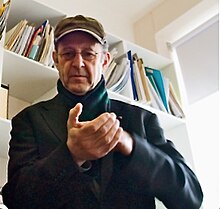Type a search term to find related articles by LIMS subject matter experts gathered from the most trusted and dynamic collaboration tools in the laboratory informatics industry.
| The Cave | |
|---|---|
| Multimedia opera by Steve Reich | |
 The composer in 2006 | |
| Language | English |
| Based on | The Cave of the Patriarchs |
| Premiere | October 22, 1993 Vienna |
The Cave is a multimedia opera in three acts by Steve Reich to an English libretto by his wife Beryl Korot. It was first performed in 1993 in Vienna by the Steve Reich Ensemble, conducted by Paul Hillier. The title "The Cave" refers to The Cave of the Patriarchs in Hebron, where Abraham and Sarah (and several other major religious figures) are buried.
The Cave of the Patriarchs is of unusual interest in that it is a sacred place where Muslims, Jews and Christians pray. The music and a major part of the libretto in the opera is derived directly from, and includes spoken responses from, Israeli, Palestinian and American interviewees who were asked questions about the story of Abraham. The sound track also includes readings from the religious texts that detail the story of Abraham, and a recording of the ambient sound that is found in the ancient building that surrounds the sacred site.
The opera uses recorded speech as a source for melodies, a technique that Steve Reich first used in the 1988 Different Trains.
The main narrative thread that runs through the opera is the story of the life of Abraham, as it is told in the various religious texts, and how this story is now understood and interpreted, using modern-day accounts by individual people from three different major religious and cultural contexts. During the individual interviews, Steve Reich and Beryl Korot asked questions such as "Who is Abraham?", "Who is Sarah?" and "Who is Ishmael?" and recorded answers that were given by Israeli, Palestinian and American interviewees. These three groups of people viewed the story of Abraham/Ibrahim and his immediate family in varying ways.

Brief spoken extracts from the interviews were used both as they were recorded during the interviews, but also as repeated musical phrases. The melodic phrases used in the opera are all taken directly from the intonation, tone, stress, and rhythm of the natural spoken phrases and sentences used by the individuals interviewed. In other words, the musical phrases are based on the prosody which can be heard in the phrases and sentences spoken by the individuals. Images of the interviewees are also shown on an array of video screens.